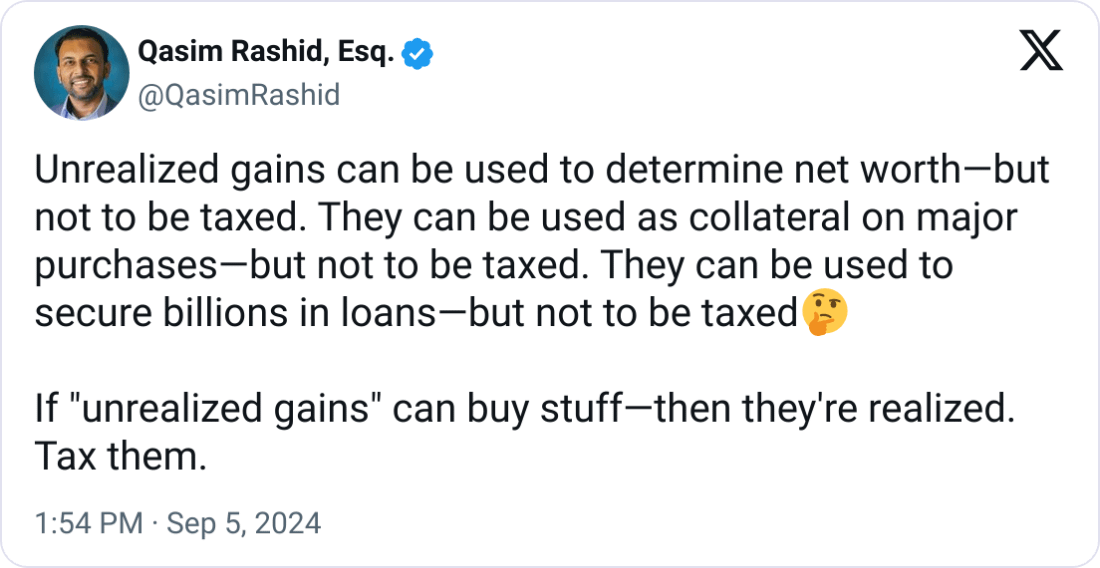this post was submitted on 19 Sep 2024
1601 points (96.8% liked)
Microblog Memes
6670 readers
3361 users here now
A place to share screenshots of Microblog posts, whether from Mastodon, tumblr, ~~Twitter~~ X, KBin, Threads or elsewhere.
Created as an evolution of White People Twitter and other tweet-capture subreddits.
Rules:
- Please put at least one word relevant to the post in the post title.
- Be nice.
- No advertising, brand promotion or guerilla marketing.
- Posters are encouraged to link to the toot or tweet etc in the description of posts.
Related communities:
founded 2 years ago
MODERATORS
you are viewing a single comment's thread
view the rest of the comments
view the rest of the comments

If you're maxing out your contributions, it won't matter, except in so far as what you can earn on taxed income outside of the IRA account. That's going to be marginal relative to the contribution. And the compound returns inside the IRA make it meaningless.
Unless you're going straight into a white shoe law firm or extraordinary paying tech job after you graduate, that's pretty much everyone. But even folks going into Fortune 500 companies typically start in the $60-80k/year range and climb up from there.
The amount of money you have in the fund is going to be much larger.
Say I invest $5000/year up front and get a 10% return for 40 years. I'm looking at putting in $200,000 over that time and taking out $2.2M.
Assuming the tax rate is 25% for each of those years, I paid $50k in taxes to invest that initial $200k. But I get the $2.2M back tax-free.
If I put the $200k in tax-deferred, I have to pay $550k to get my balance out again.
Now, we can argue that I could put the $400/year in deferred taxes into a taxable savings account. And maybe we get clever by shielding that investment from taxation annually because we just shove it all in Microsoft or Berkshire B and let it ride. That nets me another $177k over 40 years, assuming the same rate of return (for which I'm still on the hook at 15% long term gains rate - so really only $150k).
The ROTH is $350k better. That's the whole reason the fund exists. It's another accounting gimmick to give wealthy people a stealth tax cut. Only suckers put their money in Trad IRAs.
You seem to be using many different assumptions separately. In the first you assume you are maxing a Roth IRA (in my initial response I was also considering 401ks as many of them have Roth options nowadays). If you are maxing your Roth 401k and Roth IRA you are likely a high earner and therefore likely in a higher tax bracket than you will be in retirement. This means that kind of person will likely prefer traditional investments.
Your assumption there is someone maxing out their retirement options and in a relatively low tax bracket doesn't seem like reality. So in your math example they wouldn't be putting the extra in a taxable brokerage account but in the same tax advantaged account.
Quick edit: also I'm confused on the extra $400/year into taxable account. It should be $1,250 per year (25% of the 5,000) which would be closer to $600,000 before the capital gains tax.
You can't max both, you have to choose between them.
The math doesn't change if your contributions are smaller. This is a game of percentages.
You definitely can max both a 401k and IRA you can also max an HSA. All these combined allow for an individual (not family) to save $34,150 (there are some edge cases I'm ignoring). Someone who can afford to save almost the US median salary amount is almost certainly going to have a higher benefit from traditional than Roth.
Also, the math completely changes if you aren't maxing because if you aren't maxing the contribution than adding more to the contribution gives you more tax advantaged investments (instead of taxable brokerage investments).